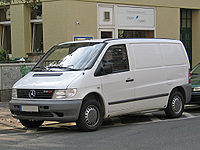Mercedes-Benz Vito
| Manufacturer | Mercedes-Benz |
|---|---|
| Parent company | Daimler-Benz DaimlerChrysler AG (from 1998) Daimler AG (from 2007) |
| Production | 1996–present |
| Assembly | Juarez, Mexico Madrid, Spain |
| Predecessor | Mercedes-Benz MB100 |
| Class | van |
The Mercedes-Benz Vito is a light van produced by Mercedes-Benz in Mexico and Spain.
It is available as a standard panel van, or with additional passenger accommodation substituted for part or all of the load area.
Generation 1 Vito
The first generation Mercedes-Benz Vito was produced between 1996 and 2003. It is powered either by a diesel engine with up to 120 bhp (89 kW; 122 PS) or a petrol engine with up to 140 bhp (104 kW; 142 PS) and a front-wheel drive drivetrain.
Generation 2 Vito
The second generation Mercedes-Benz Vito is more streamlined than its predecessor, but more importantly is powered by a new range of engines and a rear-wheel drive (RWD) drivetrain.
The angle of the windshield and A-pillar is closer to horizontal; the dashboard is bigger and the hood smaller. The newer Vito is available in 3 different lengths and 4 diesel engine versions being the 109 cdi, the 111 cdi, the 115 cdi and the powerful 120 cdi. The model numerics conform with the Mercedes pattern that relates to a rough guide to engine power output. In the Vito range currently the 109 has 93 bhp, 111 relates to 116 bhp, 115 to 150 bhp (112 kW; 152 PS) and 120 to 204 bhp (152 kW; 207 PS).
The 2nd generation Vitos are all Euro 3 compliant (additionally Euro 4 compliant as of November 2006) and therefore exempt from the upcoming Low Emission Zone in London. This requires commercial vehicles (vans) to reach at least Euro 3 standard from October 2010.
London Taxi variant
In August 2008 a variant of the Vito was approved by the Public Carriage Office for use as a licensed London 'black cab'. The Vito taxicab includes sliding doors, electric steps and seating for six people. The Vito's rear-wheel steering enables it to meet the PCO's strict 25 ft (7.6 m) turning circle rule and it is able to carry two wheelchairs. The vehicle, a variation of the 'Traveliner' model, will be produced by EcoCity under licence from Mercedes-Benz, and distributed through its KPM-UK Taxis subsidiary.
Because the Mercedes Taxi has sliding doors the option of opening windows is no longer available to passengers. The PCO (Public Carriage Office) has also specified that the option of sliding windows has also been banned, this is due to the danger of passengers having part of their body out of the windows when the doors open.
The new Taxi doesn't perform the famous u-turn in the same way as the TX and Metro models, instead it incorporates Mercedes new LSM (Low Speed Maneuverability) system activated by a button adjacent to the steering wheel. This turns the rear wheels in the opposite direction to the front wheels, thus allowing the Taxi to perform the same tight turning circle as the TX and Metro models. This system is only possible when the vehicle is traveling less than than 5 mph, and if the vehicle goes over 5 mph while the LSM is active, it is deactivated and the wheels straighten up.
It is longer and wider than the TX models, but traveling through tight spaces is aided by the option of electric folding wing mirrors.





![Validate my RSS feed [Valid RSS]](valid-rss-rogers.png)















































































ไม่มีความคิดเห็น:
แสดงความคิดเห็น